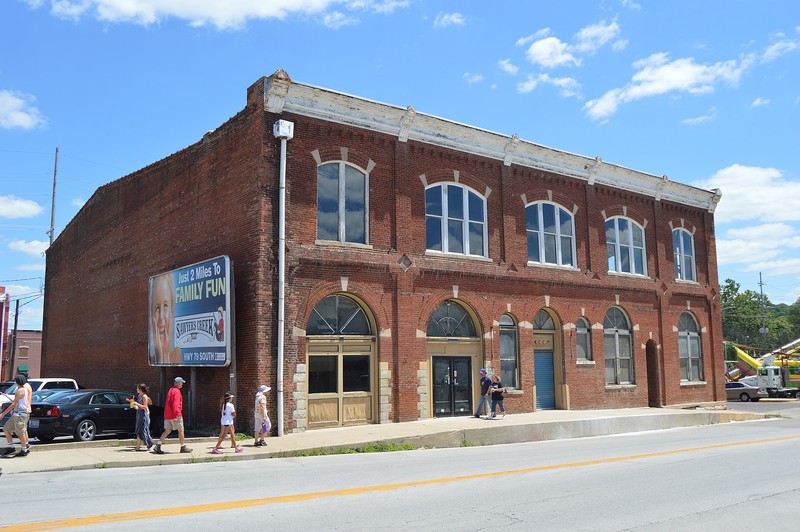Robert Elliott's Wholesale Grocery Building
Introduction
Text-to-speech Audio
Constructed in 1890 by Robert Elliott to support his distribution network that supplied area grocery stores, this historic structure serves as a reminder of a period of rapid growth in Hannibal. Elliott moved with his wife to Hannibal during the 1870s and became one of the most prosperous merchants in the area. He was also a champion of free public libraries and president of several business organizations. The grocery business benefited and supported the town's prolific river trade industry. However, Elliot's immense success proved short-lived and he went bankrupt in 1897. William J. Roth, who already had a retail grocery in the west end of town, took over the building at that time.
Images
Robert Elliott's Wholesale Grocery

Backstory and Context
Text-to-speech Audio
Robert Elliott was born in England in 1846 and came with his family to the United States in 1855, settling in Massachusetts. Elliot's brother, Sgt. Joseph Elliott died in service during the Civil War at the age of 26. In 1869, Elliott, at the age of 24, married Alice Maria Reed in Taunton, MA; they had three daughters.
Robert Elliott moved his young family to Hannibal, Missouri, during the early part of the 1870s. By 1881, he partnered with Frank W. Wyman to operate a wholesale grocery warehouse. Hannibal's early economy was based on river trade; flour, pork, and other local products were shipped out, while virtually everything else was imported, much of it to be sent on to points farther inland. Improved roads and railroads reduced the need for this service, but it survived in part as the wholesale grocery business, including Robert Elliott's Wholesale Grocery business.
During 1890, a new grocery warehouse, operated by Dulany and Robert Elliott, was completed and was in operation, built of concrete and steel with a brick exterior. Elliott's wholesale grocery arose concurrently with Hannibal's commercial building boom. In addition to the grocery business, during the 1880s and 1890s, Elliot served as president of the Hannibal Board of Trade, president of the Merchants and Mechanics Loan and Building Association, president of Hannibal's board of education, president of the Hannibal Free Public Library, and the local Republican Party chapter attempted to nominate Elliot for governor. His wife, Alice, represented the Hannibal Women's Club at the first annual convention of the Missouri State Federation of Women's Clubs, held in Kansas City.
Hannibal and his family lived as social elites within Hannibal, resided in a nice home, and were members of Hannibal's trendy Congregational Church.
In 1897, Elliott's financial success came to an end and he and his family left Hannibal and returned to Massachusetts where he took a job as an insurance agent in Boston. The financial collapse apparently took a significant toll on Elliot as he later traveled to Chicago to undergo treatment at a sanatorium.
Meanwhile, William J. Roth took over the historic building and grocery business in 1901. He restored the success of the wholesale grocery business Elliot helped build, and it once again became one of the most extensive wholesale grocery establishments in central Missouri. Roth enjoyed his own brand of success, operating several companies and gaining wealth in the process. In 1904, Roth established the Hannibal Trust Company serving as its president. The company operated as a bank, loan center, insurance company, and more, becoming a significant aspect of Hannibal's commercial activities. In 1905, Hannibal's Business Men's Association, a promoter of the city's commercial interests, reorganized as the Retail Merchants' Association. The new group created a factory committee to look after factories and other enterprises desiring to locate in the city; W. J. Roth served on that committee.
Elliott returned to Massachusetts after his treatment in Chicago, but he died shortly thereafter, in the summer of 1908, at 62 years old, but his daughters continued to prosper. Elliott's youngest daughter, Ruth, graduated college and went on to teach high school in New Jersey until the Great Depression. During the 1930 and 1940s, she served as an executive secretary for a religious organization in Manhattan, N.Y, living at the Madison Square Hotel on Madison Avenue. Meanwhile, Elliott's oldest daughter, Katherine Reed Elliott, a graduate of Wellesley College in Alberta and Oxford University, was featured in the 1914 edition of Woman's Who's Who of America. Alice Elliot married Thomas Brown, whose family operated a successful jewelry business (Brown Bros' Jewelers). In 1905, Thomas and Alice Brown moved to Quincy, IL, where he opened a jewelry store. By the 1920s, the couple moved to Chicago, where Brown took a job with the Marshal Field Department Store. Alice's mom and Robert Elliot's widow, Alice, lived with the couple in Chicago.
Sources
Greene, C. P, Thomas H. Bacon and Sidney J Roy. A Mirror of Hannibal. Hannibal: C.P. Greene, 1905. https://archive.org/details/mirrorofhannibal00gree/page/n7/mode/2up.
Hamilton, Esley. "Hannibal Central Business District Multiple Resource Nomination." National Register of Historic Places. mostateparks.com. 1985. https://mostateparks.com/sites/mostateparks/files/Broadway%20District.pdf.
Montgomery, Mary Lou. "Hannibal history: Market Street in Hannibal was busy shopping district in 1885." maryloumontgomery.com, reprinted from the Hannibal Courier-Post. December 15, 1979. Accessed November 5, 2022. https://www.maryloumontgomery.com/single-post/2014/10/06/hannibal-history-market-street-in-hannibal-was-busy-shopping-district-in-1885.
--- --- --- "History in Hannibal: The rise and fall of Robert Elliott's financial world." Courier-Post. Nov 9, 2020. https://www.hannibal.net/archive/article/history-in-hannibal-the-rise-and-fall-of-robert-elliotts-financial-world/article_8a0ec01e-4a54-5886-a4fe-ebbc969e1ed8.html.
By Nyttend - Own work, Public Domain, https://commons.wikimedia.org/w/index.php?curid=34530472
